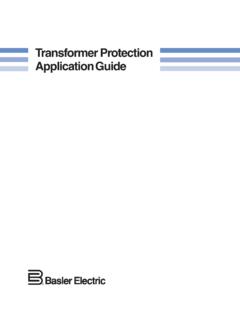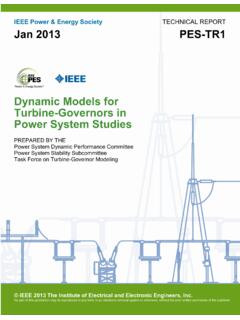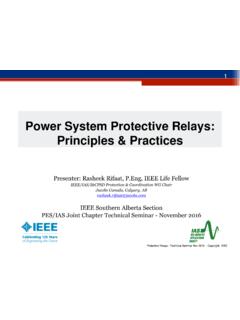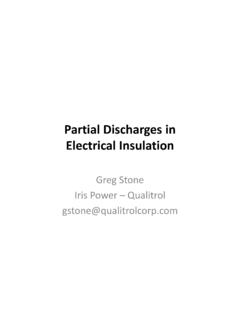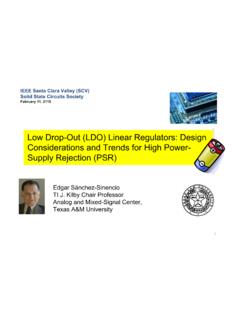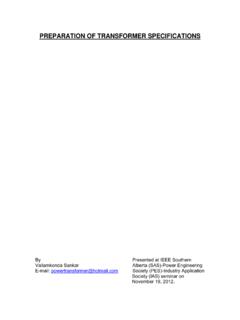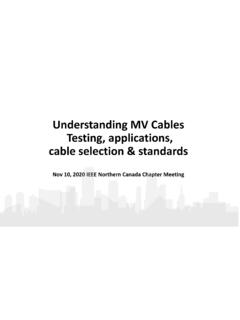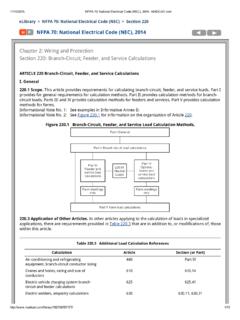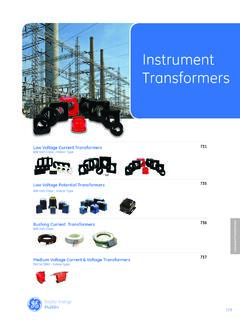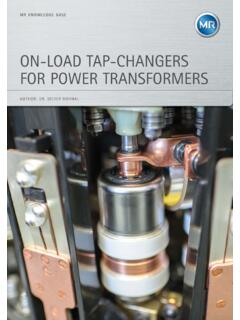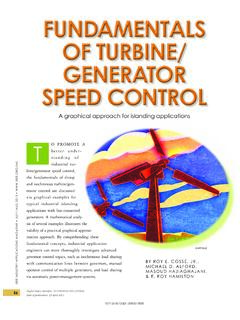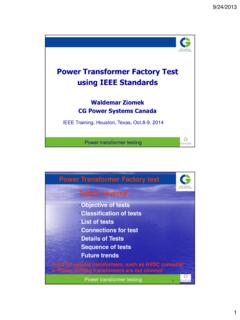Transcription of REACTIVE POWER AND VOLTAGE CONTROL
1 REACTIVE POWER AND VOLTAGE REACTIVE POWER AND VOLTAGE CONTROLS alvador Acha Daza, Ph. Distinguished POWER LecturerJune 2014 Guide1 MODELINGA ssumptions and V, I, P, QTransformers, Transmission Lines, GeneratorsSVC s (static VAR compensators)2 BASICS ABOUT VOLTAGE CONTROLQ-V relationReactive POWER flow and incremental modelDecupled Load-FlowTap s CONTROL and generalized controlTap s CONTROL and generalized control3 SENSITIVITY Q-V AND COORDINATED CONTROLS ensitivity coefficientsApplication and coordinatedcontrolQ-V CongestionRadial networks4 VOLTAGE COLLAPSEA ngle stabilityVoltage collapse2 Modeling3 Single phase, steady state: VOLTAGE , Current AC VOLTAGE and current, f = 60 Hz rms values: 120 V, 50 A If current lags voltageby 30o+V-ILoadconvention150v(t)4 VIfPhasor , secvoltage V, current Ai(t)v(t)Complex POWER S, P and QVAjSjQPIVSoo000, ,5)3050()0120(** QfSIPQ5 PQfPower plane cos fis the POWER factor The case shows a lagging POWER factor +V-LoadconventionRjwLWhat is P and Q?
2 Instantaneous POWER p(t):)sin()cos()2sin()sin())2cos(1()cos( )()cos()cos()()()( IVQIVPtIVtIVtptItVtitvtpmm 2,2mmIIVV rms , secinstantaneous POWER p(t) , secpower, components I and IIQV oltage and current, steady state)()(DDsXxjRrVI Positive sequencexjr DDXjR sVIAssuming load and VOLTAGE as a fixed value (no use of load flow), ZLine= + WPower factor effect on VOLTAGE , angle and losses7 POWER factor effect on VOLTAGE , angle and lossesNominal load VOLTAGE and current (rms values) source angle PS QS PL QL pf(load) Losses % + + + ModelFor an ideal transformer with complex relation8 tVVkk1'~~ **''~~kmkkmkiViV tVViikkkmkm~'~'**Complex, real and REACTIVE POWER , from k to m: **~'~~'~~kmmkkkmkkmkkmyVVtVitViVs mkkmmkmkkmmkkmkkmbtVVgtVVgtVpsincos22 mkkmmkmkkmmkkmkkmbtVVgtVVbtVqcossin22 Transmission line modelA symmetric arrangement for a balanced transmission line, positive sequence values, using ~mjmmeVV ~kmkmkmjbgy 2/2/2/1shCshjBjXy Complex POWER flow from k to mmkkm *,)(~shkkmkkmiiVs kmkmmkkmkmmkkmkkmbVVgVVgVp sincos2 kmkmmkkmkmmkshkmkkmbVVgVVBbVq cossin)(2/2 Simple synchronous machine modelSingle phase model, synchronous machine no saliency.
3 AsIXjVE IVEjXEquivalent circuit for synchronous machineSynchronous machine +E-Ia+V-Zs= Ra+ jXs10 IajXsSynchronous machine connected to an infinite busIaVEZsIadIaVEZsIadIaVEZsIadqLoad with lagging POWER factorLoad with unity pfLoad with leading pfSVC relation -VVmQB = BminB = +VoTCRcapacitiveinductiveB = 0 + (Thyristor Switched Capacitor)TCR (Thyristor Controlled Reactors)Basics about VOLTAGE Control12 REACTIVE POWER flow, Incremental ModelFor a complex transformer in a balanced three phase POWER system, REACTIVE POWER :13 mkkmmkmkkmmkkmkkmbtVVgtVVbtVqcossin22 Incremental REACTIVE POWER Dqkm:ttttqVVVVqVVVV qqqqqkmmmmmkmkkkkkmkmmmkmkkkmkm ApproximationsReasonable assumptions will simplify the incremental REACTIVE POWER flow, like: mkkmkkkmbVq mkkmkmkmbVq )cos( mkmk)sin(kmkmbg 14 mkkmkbVkmkkkmbVVq kmkmkmbVVq kmkkmbVtq Substitution into the incremental form:tVVVqxmkkkmkm )cos( mkOhm s law and equivalent circuitOhm s circuit to study the incremental REACTIVE POWER flow in a complex tap transformer:tVVVqxmkkkmkm 15B.
4 Stott, O. Alsac, Fast Decoupled Load Flow, IEEE Trans. On POWER Apparatus and Systems, Vol. PAS-93, May-June, circuit for Dq in a transmission lineA similar procedure will give us an incremental circuit equivalent for a transmission line. The right hand side comes from the line charging 2/2)(+D Vk -+D Vm -+ -+ -xkmDqkm/ Vk 16 Apply an incremental model for each transformer and transmission line. Ohm s law and Kirchhoff's current law are used to set up a system ofequations Solve for CONTROL actions on nodal variables and transmission CONTROL by tap transformers Q3 Q4 Q5 Q654(4)(5)177 Ref Q1 Q2 t: 17165432 q71 q21 q23 q34 q45 q56 q76 q25(1)(2)(3)(4)(5)(6)(7)(8) Q77 Ref Q1 Q2 Q3 Q4 Q5 Q6 t: 17165432 q71 q21 q23 q34 q45 q56 q76 q25(1)(2)(3)(4)(5)(6)(7)(8) Q7 Ohm s law for every element(1)0177171 VVqx(2)tVVqx 122121(3)0322323 VVqx(4)0433434 VVqx(5)0544545 VVqx(6)0522525 VVqx(7)0655656 VVqx(8)0677676 VVqxNode equations, Kirchoff s lawnode 1 12171 Qqq node 2 2252321 Qqqq node 3 33423 Qqq node 4 44534 Qqq node 5 5564525 Qqqq node 6 67656 Qqq 18 Sensitivity factors )4( )3( )2( )1( Second column of the inverse )8( )7( )6( )5( )4( 19 SENSITIVITY Q-V AND COORDINATED CONTROLCOORDINATED CONTROL20 Network model and VOLTAGE - REACTIVE POWER controls1- b2323- b1222VQ - b13+DV2-1- b2323slack- b1222VQ - b13+DV3-33VQ 00322232331113132111212 VVVqxtVVVqxVVVqxSeries Elements(1)(2)(3)slackNodal Balance (including shunt currents) Node 1 Node 2 Node 33333)3(22231132222)3(2)1(22231121111)1( 21131122)(22 VQVVBVqVqVQVVBBVqVqVQVVBVqVqshtshtshtsht 21-slack-Matrix equation and Data 332211332211223113112)3(2)3(2)1(2)
5 1(2231312///00////2001100)(2010100201111 0001010001100 VQVQVQtVVVVVVVqVqVqBBBB xxxshtshtshtshtNnods = 3 Elements = 3 ConnectivityElements Nsal Nlleg R X B/2 Code1 1 2 02 1 3 13 2 3 0 Node type: 0 comp, -1 load, +1 generatorNode type1 02 -13 122If it is required to change the REACTIVE POWER flow in a given line. Controlsavailable are: a tap changer and POWER injection into nodes 2 and 3. Sensitivityvalues are used to solve for an optimal change to attain the REACTIVE flow change. change in POWER flowA cost function and constraints are required. To minimize CONTROL effort tochange the flow in line from node 2 to node 3. From sensitivity matrix: 332211332211223 23 Lagrangian and its gradient:0///..3336223532223 VQSVQStSVqas)()()()(),,(3336223532223233 32222213322 VQSVQStSVqVQkVQktkVQVQt 2333222221)/()/()(minVQkVQktk Cost function and constraintsGradient must be zero for an optimal solution.)
6 We find a set of equationsto be solved for the CONTROL actions required. 0000////2 24 This case requires to solve a system of linear : 2233322363532363352321/000//0200020002 VqVQVQtSSSSkSkSk :Smin = = = VQVQtThe coordinated changes work to modify the required value, but CONTROL limits must be included (i. e. maximum/minimum setting must be observed).25 Previous solution used k s as unit weight or importance in a CONTROL action can be handled through the k values. A change to reduce (or make larger) the CONTROL action of injected REACTIVE POWER is shown by values k2= and k3= = = VQVQt26A real network might have a structure as shown, in which nodes andtransmission elements show a radial structure; considered longitudinal ; it isnot a very robust type of network is very interesting to study CONTROL actions and magnitudeof their and Radial type networks10114101142710423915121567813141 04239151215678131415 nodes, 15 elements longitudinal network(1)(2)Figure shows the matrix structure for circuit study.
7 Elements andnodal information are in the (MW) PD(MW) node system and elements, connectivity and reactance Salida - Nodo Llegadax (pu)(1)2 - (2)3 - (3)5 - (4)7 (4)7 (5)4 - (6)3 - (7)10 - (8)12 - (9)12 - (10)1 - (11)3 (12)6 (13)11 (14)9 (15)14 - =Columns 1 through 8 0 0 0 0 0 0 0 0 0 0 00 0 0 0 0 0 0 0 0 0 0 0 0 00 0 0 0 0 0 0 0 0 0 0 0 0 0 0 0 0 0 0 0 0 0 0 0 0 0 0 0 0
8 0 0 0 0 0 0 0 0 0 0 0 0 0 0 0 0 0 0 0 0 0 RELATION AND VOLTAGE SUPPORTSUPPORT31 VOLTAGE and current, steady state)()(DDsXxjRrVI Positive sequencexjr DDXjR sVIAssuming load and VOLTAGE as a fixed value (no use of load flow), ZLine= + WPower factor effect on VOLTAGE , angle and losses32 POWER factor effect on VOLTAGE , angle and lossesLoad VOLTAGE and current, rms source angle PS QS PL QL pf(load) + + + curve and load Vm, puP-V curve, DC PL, puSystem s PV curve and for a resistive load, RL= , Acha Daza, Ph.
9 623 9953
